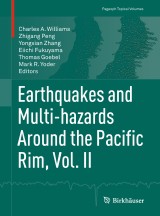Details

Earthquakes and Multi-hazards Around the Pacific Rim, Vol. II
Pageoph Topical Volumes
|
53,49 € |
|
| Verlag: | Birkhäuser |
| Format: | |
| Veröffentl.: | 16.05.2018 |
| ISBN/EAN: | 9783319922973 |
| Sprache: | englisch |
Dieses eBook enthält ein Wasserzeichen.
Beschreibungen
This is the second of two volumes devoted to earthquakes and multi-hazards around the Pacific Rim. The circum-Pacific seismic belt is home to roughly 80% of the world’s largest earthquakes, making it the ideal location for investigating earthquakes and related hazards such as tsunamis and landslides. Following the Introduction, this volume includes 14 papers covering a range of topics related to multi-hazards. The book is divided into five sections: viscoelastic deformation, earthquake source models, earthquake prediction, seismic hazard assessment, and tsunami simulation.<p>Viscoelastic relaxation can play an important role in subduction zone behavior, and this is explored in the first section, with specific examples including the Tohoku-oki earthquake in Eastern Japan. In addition to laboratory rock friction experiments, the second section examines earthquake source models for the 2016 <i>M<sub>W</sub></i> 6.6 Aketao earthquake in Eastern Pamir and two earthquakes in Eastern Taiwan, along with strong ground motion studies of the 2008 <i>M<sub>W</sub></i> 7.9 Wenchuan, China earthquake. The Load/Unload Response Ratio (LURR), Natural Time (NT), and “nowcasting” are earthquake prediction techniques that are analyzed in the third section, with nowcasting predictions performed for a number of large cities globally. Viscoelastic relaxation can play an important role in subduction zone behavior, assessment are the focus of the fourth section, with specific applications to the Himalayan-Tibetan region and the Xianshuihe Fault Zone in Southwest China. In the last section, a new approach in modeling tsunami height distributions is described.</p><p>Rapid advances are being made in our understanding of multi-hazards, as well as the range of tools used to investigate them. This volume provides a representative cross-section of how state-of-the-art knowledge and tools are currently being applied to multi-hazards around the Pacific Rim. The material hereshould be of interest to scientists involved in all areas of multi-hazards, particularly seismic and tsunami hazards. In addition, it offers a valuable resource for students in the geosciences, covering a broad spectrum of topics related to hazard research.</p><div><br></div>
Earthquakes and Multi-Hazards Around the Pacific Rim, Vol. II: Introduction.- Subduction Mode Selection During Slab and Mantle Transition Zone Interaction: Numerical Modeling.- Characteristics of Viscoelastic Crustal Deformation Following a Megathrust Earthquake: Discrepancy Between the Apparent and Intrinsic Relaxation Time Constants.- Interpretation of Offshore Crustal Movements Following the 2011 Tohoku-Oki Earthquake by the Combined Effect of Afterslip and Viscoelastic Stress Relaxation.- Rupture Characteristics of the 25 November 2016 Aketao Earthquake (<i>Mw</i>6.6) in Eastern Pamir Revealed by GPS and Teleseismic Data.- Source Characteristics of the Northern Longitudinal Valley, Taiwan Derived from Broadband Strong-Motion Simulation.- Fault Structural Control on Earthquake Strong Ground Motions: the 2008 Wenchuan Earthquake as an Example.- Voids and Rock Friction at Subseismic Slip Velocity.- A Dimensional Analysis Method for Improved Load/Unload Response Ratio.- Natural Time, Nowcasting and the Physics of Earthquakes: Estimation of Seismic Risk to Global Megacities.- Natural Time and Nowcasting Earthquakes: Are Large Global Earthquakes Temporally Clustered?.- Optimal Scaling of Aftershock Zones Using Ground Motion Forecasts.- Probabilistic Seismic Hazard Assessment for Himalayan-Tibetan Region from Historical and Instrumental Earthquake Catalogs.- Scenario-Based Seismic Hazard Analysis for the Xianshuihe Fault Zone, Southwest China.- Tsunami Simulation Method Assimilating Ocean Bottom Pressure Data near a Tsunami Source Region.
This is the second of two volumes devoted to earthquakes and multi-hazards around the Pacific Rim. The circum-Pacific seismic belt is home to roughly 80% of the world’s largest earthquakes, making it the ideal location for investigating earthquakes and related hazards such as tsunamis and landslides. Following the Introduction, this volume includes 14 papers covering a range of topics related to multi-hazards. The book is divided into five sections: viscoelastic deformation, earthquake source models, earthquake prediction, seismic hazard assessment, and tsunami simulation.<p>Viscoelastic relaxation can play an important role in subduction zone behavior, and this is explored in the first section, with specific examples including the Tohoku-oki earthquake in Eastern Japan. In addition to laboratory rock friction experiments, the second section examines earthquake source models for the 2016 <i>M<sub>W</sub></i> 6.6 Aketao earthquake in Eastern Pamir and two earthquakes in Eastern Taiwan, along with strong ground motion studies of the 2008 <i>M<sub>W</sub></i> 7.9 Wenchuan, China earthquake. The Load/Unload Response Ratio (LURR), Natural Time (NT), and “nowcasting” are earthquake prediction techniques that are analyzed in the third section, with nowcasting predictions performed for a number of large cities globally. Strong ground motions and seismic hazard assessment are the focus of the fourth section, with specific applications to the Himalayan-Tibetan region and the Xianshuihe Fault Zone in Southwest China. In the last section, a new approach in modeling tsunami height distributions is described.</p><p>Rapid advances are being made in our understanding of multi-hazards, as well as the range of tools used to investigate them. This volume provides a representative cross-section of how state-of-the-art knowledge and tools are currently being applied to multi-hazards around the Pacific Rim. The material here should be of interest to scientists involved in all areas of multi-hazards, particularly seismic and tsunami hazards. In addition, it offers a valuable resource for students in the geosciences, covering a broad spectrum of topics related to hazard research.</p><div><br></div>
Explores viscoelastic relaxation in subduction zone behavior Examines earthquake source models for the 2016 MW 6.6 Aketao earthquake Covers specific applications to the Himalayan-Tibetan region and the Xianshuihe Fault Zone in Southwest China
Diese Produkte könnten Sie auch interessieren:

Contaminated Soils, Sediments and Water:

von: Edward J. Calabrese, Paul T. Kostecki, James Dragun

149,79 €















